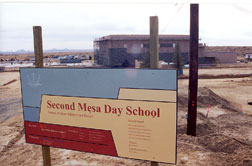Even with a 1990s-era building moratorium still in effect, BIA, which is part of the Dept. of Interior, received a helping hand in its mission from the Clinton and Bush administrations and the No Child Left Behind Act of 2001. BIA’s construction and maintenance budget tripled from $90 million in 1999 to a peak of $323 million in 2002 and now hovers around $150 million.
 |
Alternative project delivery project delivery methods helped open many schools in time for classes. BIA’s planning and construction process for schools traditionally took a long time, lasting seven years or more from design to completion. Some delays were unique to the agency. Tribal communities often demand input on the architecture so that it reflects their cultural heritage. And BIA school projects entail an unusually high amount of infrastructure work due to remote work sites, adding $25 per sq ft or more to the total cost, say BIA officials.
|
BIA often has to extend roads, electric power, water, sewer and telephone lines from miles away to the projects. It also requires contractors to build teacher housing on school grounds. And work only can start when federal appropriations are in place, which often occurs years after design completion and budget estimates. Although BIA generally withholds 5% as a project contingency, it seldom has the ability to add funds.
Until recently, the agency relied on traditional design-bid-build delivery that awarded contracts to the lowest, prequalified bidder. But that process became increasingly burdened with delays and cost overruns. “Our program has been very volatile due to Davis-Bacon [prevailing wage requirements], concrete and steel prices and labor availability,” says Boyd Robinson, deputy director of BIA’s Office of Facilities Management and Construction, Albuquerque, N.M., which oversees eight regions with a combined staff of 180. “We’ve had to get smarter and diversify.”
Faster
In 2000, Boyd's office turned to design-build and project bundling on small facility repairs. Its first design-build project was the $12.2-million, 79,000-sq-ft Baca/Dlo’ay Azhi Community School on the Navajo Reservation in northwestern New Mexico, completed by the U.S. Army Corps of Engineers in 2003. BIA also started allowing contractors to front-load projects in order to lock down fluctuating materials prices. The changes cut the seven-year process in half. BIA now completes one to two schools a year and dozens of repairs.
The new approach also has attracted contractors that previously shunned BIA work. Phoenix-based Kitchell Contractors is one. “Once upon a time, BIA was very reluctant to use any other delivery method than a competitive bid,” says Brad Gabel, vice president of Kitchell’s Native American division. “Their desire to move quicker led them to pursue alternative delivery methods, which prompted us to pursue BIA work.”
 |
Kitchell is presently building the $16-million, 69,000-sq-ft Second Mesa Day School on the Hopi tribe’s reservation in northeastern Arizona under a construction manager at-risk contract. It is on budget and scheduled to finish in 2007.
BIA negotiates design and engineering services from a pool of prequalified firms based on experience, skills and financials. Preference is given to Native American-owned companies. BIA determines project size, scale and priority based on tribal demographics and need.
BIA has committed to pursuing LEED (Leadership in Energy and Environmental Design) certification on its schools. LEED is a six-year-old rating method developed by the U.S. Green Building Council, Washington, D.C., that grades project sustainability on a points system awarded for energy and atmosphere, water efficiency and indoor air quality, among other things. The more points, the higher the rating, which starts at basic and moves up to platinum.
BIA achieved a silver rating for the Baca/Dlo’ay Azhi Community School and a basic certification for the $16.6-million, 74,000-sq-ft First Mesa Elementary School on the Hopi reservation, west of Polacca, Ariz. Kitchell completed it in 2004.
 |
| Above center: Many contracting changes were made under Interior Secretary Gale Norton. |
LEED makes an important environmental and cultural statement for Native Americans, whose traditions are rooted in nature. BIA hopes LEED ratings also will translate into operational savings. “Pursuing LEED adds 1% to 2% to the project cost, but we expect to recoup [that over] the building’s lifespan through energy savings,” says BIA spokesman Mark Hopwood.
After conducting an evaluation process, BIA can either build or repair a facility on behalf of the tribe or provide it with a federal grant, which it does 60% of the time. Federal contracting rules still apply when the tribe builds a facility itself under a BIA grant, although the tribe still retains sovereignty. That sovereignty and dispute resolution remain key concerns for contractors. If a dispute occurs, there may be no means for recourse unless the contract outlines a specific resolution. Contractors often will seek a limited waiver of sovereignty before committing to a project, or they will seek an escrow account for the contract amount, along with mediation or arbitration as a method of dispute resolution.
These all are legitimate concerns, says Kevin Gover, an affiliate professor at Arizona State University’s American Indian Studies Program. “Tribes worry about accountability. If things go wrong, the people won’t blame the contractor, they'll blame tribal leaders,” he says. “The dispute resolution contract language is like a pre-nuptial. It’s best to plan for the worst.”
(Photos courtesy of the Bureau of Indian Affairs)
he Bureau of Indian Affairs, the federal agency that oversees construction, maintenance and repair of over 7,000 tribal buildings totaling 27 million sq ft in 23 states, needed to change its ways. Nearly 60% of 184 reservation schools under its care were old and in woeful shape. How could the agency fight the inertia of a bureaucratic federal construction process to jumpstart a new schoolbuilding program for the reservation? The answer was alternative project delivery.
Post a comment to this article
Report Abusive Comment